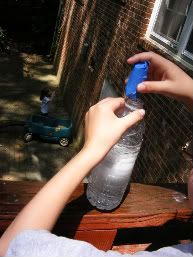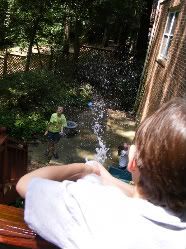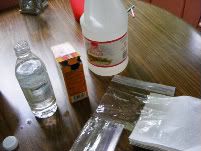L. and I have been sending off vinegar and soda bottle rockets since he was about three years old. In fact, one of my many treasured memories is of a sunny afternoon one spring when L. was three--the first time ever we tried the experiment. We were standing in the back yard at our old house, and L. had been waiting all morning for me to get home from work. He had very high expectations for the experiment--as he does these days, too, for any experiment we undertake. Achieving anything less than perfection--or less than the results he imagines in his head--is unacceptable.
The first few cork rockets we shot off were exciting, but they didn't go as high as he wanted them to. Finally, the last one shot straight up, into some trees, I think, but it never came down again. We waited, we looked, and we never found it. L., with the optimistic wonder all children possess, finally concluded that it had shot so very high into the sky that it was orbiting around the earth. In fact, for a full year after that day he truly believed the cork was up there, spinning like a tiny satellite. And even though in my practical grown-up mind I know the cork must have ended up in some tree, I still like to sometimes look up into the sky and smile, imagining too that the cork is still there, turning over and over on itself, endlessly, in some impossible orbit around our earth.
***********
My three-year old has turned into an almost nine-year old who needs a little more bang for his buck in his experiments these days. Despite this, the vinegar rockets still delight him. When our friends came over for the noodles and marshmallows project, we also set off a few vinegar and soda rockets, with resounding success. The first few were messy, but once we had gotten the timing of it all down pat, the last few cork rockets went off perfectly.
All you need for the experiment are a few empty water bottles, some corks, some duct tape (we used painter's tape), vinegar, baking soda, and water.
Fill the bottle about halfway with vinegar, then add about 1/2 cup water (you might need to tinker with these ratios depending on the results). Then, take a square of toilet paper and place about 1-2 two tablespoons of baking soda in the middle. Wrap it all up, and twist the top to make it stay together.
Next, find a cork to fit into the mouth of the bottle. If the cork is too loose, wrap it in tape to make it fit snugly.
 Now, here's the tricky part: you have to be fast and drop the soda packet in while at the same time jamming the cork into the mouth of the bottle. When you've done this give the bottle a shake, aim into the sky, and watch the cork rocket shoot off!
Now, here's the tricky part: you have to be fast and drop the soda packet in while at the same time jamming the cork into the mouth of the bottle. When you've done this give the bottle a shake, aim into the sky, and watch the cork rocket shoot off!
 If the cork rockets don't quite satisfy your budding scientist's thirst for mini explosions, you can make a bubble bomb. This isn't as dangerous as it sounds, and the experiment is a good way to teach kids about the consequences of pressure build-up (you can also use the exploded bag to illustrate to your kids what you, the parent, feels like some days when you've been pushed to the limit).
Here's all your need for the exploding bag experiment.
If the cork rockets don't quite satisfy your budding scientist's thirst for mini explosions, you can make a bubble bomb. This isn't as dangerous as it sounds, and the experiment is a good way to teach kids about the consequences of pressure build-up (you can also use the exploded bag to illustrate to your kids what you, the parent, feels like some days when you've been pushed to the limit).
Here's all your need for the exploding bag experiment.
 I know, I know, AGAIN with the vinegar and soda...
We found the experiment worked best with actual ziploc bags. The bags you press closed with your fingers worked well, but they tended to pop open instead of explode, and a pop is always a little anticlimactic when you're anticipating something a little more dramatic to happen.
Happy exploding!
I know, I know, AGAIN with the vinegar and soda...
We found the experiment worked best with actual ziploc bags. The bags you press closed with your fingers worked well, but they tended to pop open instead of explode, and a pop is always a little anticlimactic when you're anticipating something a little more dramatic to happen.
Happy exploding!
 Now, here's the tricky part: you have to be fast and drop the soda packet in while at the same time jamming the cork into the mouth of the bottle. When you've done this give the bottle a shake, aim into the sky, and watch the cork rocket shoot off!
Now, here's the tricky part: you have to be fast and drop the soda packet in while at the same time jamming the cork into the mouth of the bottle. When you've done this give the bottle a shake, aim into the sky, and watch the cork rocket shoot off!
 If the cork rockets don't quite satisfy your budding scientist's thirst for mini explosions, you can make a bubble bomb. This isn't as dangerous as it sounds, and the experiment is a good way to teach kids about the consequences of pressure build-up (you can also use the exploded bag to illustrate to your kids what you, the parent, feels like some days when you've been pushed to the limit).
Here's all your need for the exploding bag experiment.
If the cork rockets don't quite satisfy your budding scientist's thirst for mini explosions, you can make a bubble bomb. This isn't as dangerous as it sounds, and the experiment is a good way to teach kids about the consequences of pressure build-up (you can also use the exploded bag to illustrate to your kids what you, the parent, feels like some days when you've been pushed to the limit).
Here's all your need for the exploding bag experiment.
 I know, I know, AGAIN with the vinegar and soda...
We found the experiment worked best with actual ziploc bags. The bags you press closed with your fingers worked well, but they tended to pop open instead of explode, and a pop is always a little anticlimactic when you're anticipating something a little more dramatic to happen.
Happy exploding!
I know, I know, AGAIN with the vinegar and soda...
We found the experiment worked best with actual ziploc bags. The bags you press closed with your fingers worked well, but they tended to pop open instead of explode, and a pop is always a little anticlimactic when you're anticipating something a little more dramatic to happen.
Happy exploding!